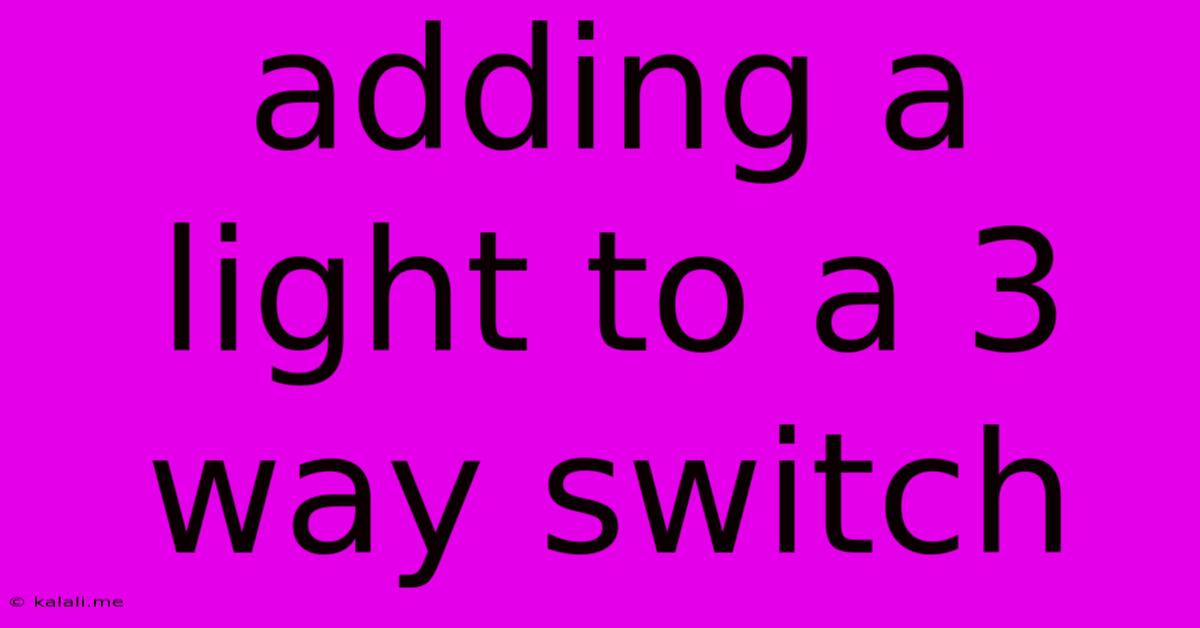Adding A Light To A 3 Way Switch
Kalali
Jun 05, 2025 · 4 min read

Table of Contents
Adding a Light to a 3-Way Switch Circuit: A Comprehensive Guide
Adding a light fixture to an existing 3-way switch circuit might seem daunting, but with the right knowledge and careful execution, it's a manageable DIY project. This guide provides a step-by-step walkthrough, covering safety precautions, necessary materials, and the wiring process. Remember to always prioritize safety and turn off the power before starting any electrical work. This project requires basic electrical knowledge; if you're unsure about any step, consult a qualified electrician.
Understanding 3-Way Switching
Before diving in, it's crucial to understand how 3-way switches function. Unlike a standard single-pole switch, a 3-way switch uses two switches to control a single light fixture from two different locations. This system uses a unique wiring configuration involving traveler wires that connect the two switches. Adding a light means carefully integrating it into this existing circuit without disrupting the functionality of the original setup.
Materials You'll Need:
- New Light Fixture: Choose a fixture compatible with your existing wiring and desired aesthetic.
- Electrical Box: Ensure it's rated for the new fixture's weight and the number of wires it will house. An additional box might be necessary depending on your current setup.
- Wiring: Romex cable (or equivalent) matching your existing wiring gauge. This will likely involve 14-2 or 12-2 gauge wire.
- Wire Nuts (Wire Connectors): Sufficient quantity for all wire connections.
- Voltage Tester: Essential for verifying power is off and confirming wire connections.
- Screwdrivers: Phillips and flathead, appropriate sizes.
- Wire Strippers/Cutters: To neatly prepare the wires for connections.
- Electrical Tape (optional): For extra insulation, although wire nuts provide sufficient insulation in most cases.
- Fish Tape (possibly): If you need to snake wires through walls or ceilings.
Step-by-Step Guide:
-
Turn Off the Power: This is the most crucial step. Turn off the power at the breaker box to the circuit you're working with. Verify the power is off using a voltage tester on the wires at the switch and light fixture locations.
-
Access the Wiring: Remove the existing light fixture and switch plates. Carefully expose the wiring at both switch locations and the fixture location. Take photos of the existing wiring configuration for reference.
-
Add a New Electrical Box (if needed): If your new fixture requires a separate junction box, install it according to local electrical codes.
-
Connect the New Fixture: Connect the new fixture's wires to the existing circuit wires. Typically, you'll have a hot wire (black), a neutral wire (white), and a ground wire (bare copper or green). Connect these appropriately using wire nuts.
-
Extend the Circuit to the New Fixture: Run the necessary Romex cable from the existing switch box or junction box to the new fixture's box. This might involve fishing the wire through walls or ceilings, requiring fish tape. Make sure the cable is securely fastened and routed according to code. Connect the wires from the new fixture to the extended wires using wire nuts. Ensure all connections are properly insulated and secure.
-
Connect the Switches: At each 3-way switch location, connect the incoming hot wire and outgoing traveler wires appropriately. Consult the switch wiring diagram if needed. The traveler wires connect the two switches. The incoming hot wire connects to one of the switch terminals, and the outgoing hot wire will be connected to the other switch and the light. Ensure the neutral wire and ground wire are properly connected to the switch boxes.
-
Test the Circuit: Turn the power back on at the breaker box and test the new light fixture from both switch locations. Ensure it turns on and off correctly from each switch.
-
Securely Mount Everything: Securely mount the light fixture and switch plates. Tuck away any excess wire neatly and securely.
Troubleshooting:
- Light Doesn't Turn On: Double-check all wire connections, especially those at the switches. Verify the power is on at the breaker box.
- Light Flickers: There might be a loose connection or a faulty wire. Inspect all connections carefully.
Important Considerations:
- Local Electrical Codes: Always adhere to local electrical codes and regulations.
- Professional Help: If you're not comfortable working with electricity, consult a qualified electrician. Electrical work carries risks, and safety should always be the top priority.
Adding a light to a 3-way switch circuit can enhance your home's lighting and functionality. By following these steps and prioritizing safety, you can successfully complete this project and enjoy the improved illumination. Remember that this guide provides general instructions, and the specifics might vary depending on your existing wiring configuration. Always consult relevant electrical codes and, when in doubt, seek professional help.
Latest Posts
Latest Posts
-
Why Couldnt Moses Enter The Promised Land
Jun 07, 2025
-
Why Does Nasdaq Not Publish Order Book Anymore
Jun 07, 2025
-
What Is A Naturalized Or Derived Citizen
Jun 07, 2025
-
Where Can I Watch Boku No Pico
Jun 07, 2025
-
How Thick Should Concrete Be For A Driveway
Jun 07, 2025
Related Post
Thank you for visiting our website which covers about Adding A Light To A 3 Way Switch . We hope the information provided has been useful to you. Feel free to contact us if you have any questions or need further assistance. See you next time and don't miss to bookmark.